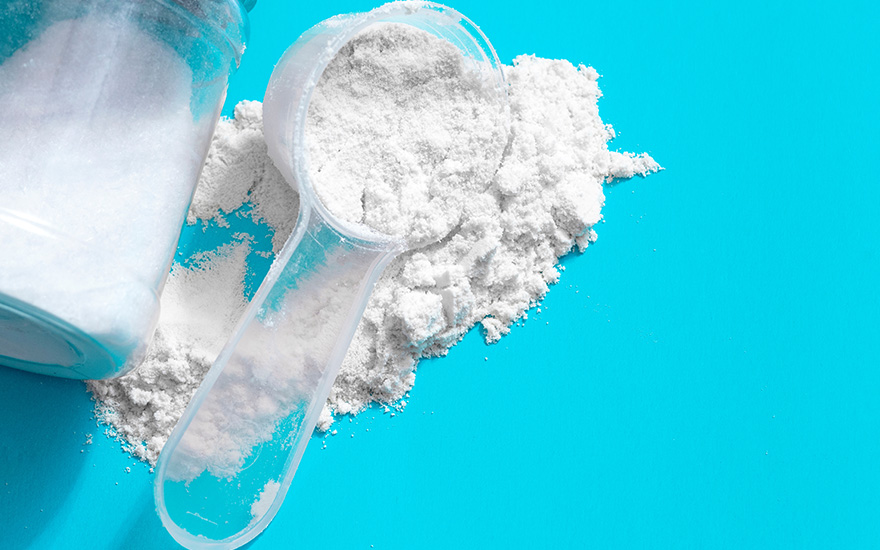Author: Curtis High
Hailed as the new hypertrophy hero, creatine is the most well-researched supplement on the market and myriad studies back that creatine benefits all ages to help improve muscle size and recovery, increase strength, and help with anaerobic endurance.
With many different forms of creatine available, it can be unclear which is most beneficial. So, for your supplementing pleasure, Muscle and Health, break down the different forms of creatine and the pros and cons of each to help you reach your fitness goals.

What is creatine?
Creatine is a molecule produced in the body that acts as an energy reserve. It’s present in all cells and in many foods like meat, fish, and eggs. Creatine gives you energy by accelerating a process through which cellular energy (adenosine triphosphate) is generated, increasing the work a cell can execute.
Most of the creatine is stored within your muscle cells, so supplementing with creatine can help boost your strength and anaerobic capacity.
How should I take creatine?
Many athletes and gym users tend to take creatine as part of their post-workout shake, but because it takes time to be absorbed within a muscle cell to provide benefits, it doesn’t matter what time of day you take it. Choose a time that suits your schedule and stick with it. Once your cell is saturated with creatine, it usually takes between three-to-five days before it will begin to have an effect.
How does creatine help you build muscle?
More strength and muscle endurance allow you to train harder and create a more significant muscle breakdown ready for recovery. That means a speedier recovery too. Research also shows creatine helps muscle cell growth, increasing the amount of water and glycogen held in muscle cells.
Creatine also has anti-catabolic properties proven to reduce degradation in muscle cells, which can help muscle growth over time.
What are the cons of taking creatine?
There are none! Studies show creatine has been proven beneficial in young children through to the older person, with zero downsides to supplementing with creatine for both short- and long-term use.

Which creatine should I choose?
Creatine monohydrate remains the standard by which all other forms of creatines are usually judged. It’s cheap and usually the best for overall performance and effect.
Micronized creatine is most commonly a creatine monohydrate that has been ground down to reduce the overall size of the powder particles. This can increase overall water solubility but doesn’t change anything regarding absorption or effectiveness.
Liquid creatine is another form of creatine monohydrate suspended in a liquid. It’s thought to be less effective12 than creatine monohydrate because when it has been suspended in water for several days, creatine breaks down into the inactive substance creatinine.
Creatine citrate is creatine bound to citric acid. Research indicates it’s more water soluble than creatine monohydrate but has no further benefits in absorption and effectiveness.
Creatine hydrochloride is creatine bound with hydrochloric acid, which is turned into an essential creatine molecule within your stomach. This makes creatine hydrochloride more water soluble than creatine monohydrate, but no further benefits in terms of being more effective.
Creatine malate is creatine bound with malic acid. Although there are studies that show malic acid can enhance your performance, it hasn’t been researched in conjunction with creatine to prove it be more effective.
Creatine pyruvate is creatine bound with pyruvic acid. It may produce higher plasma levels than creatine and monohydrate, but this doesn’t reflect in more excellent muscle absorption or enhanced performance.
Buffered creatine is a form of creatine with a higher pH level, but it isn’t any more efficacious than creatine monohydrate.
Creatine nitrate is a form of creatine bound with a nitrate group. This increases water solubility, but no research has been conducted to compare creatine nitrate to monohydrate, so it’s unknown if it’s a better choice.
Creatine magnesium chelate is a form of creatine bound to magnesium. As magnesium plays a role in creatine metabolism, it is thought to increase its effectiveness. It was found, however, that creatine magnesium chelate is more or less the same as creatine monohydrate in terms of ergogenic effects but may result in less water weight gain.
Creatine ethyl ester is a form of creatine that was said to convert back to usable creatine in the body. It’s very often marketed as having a better absorption rate than monohydrate, but studies 18 show it is, in fact, less effective than monohydrate.
Often underrated, creatine is a supplement savior that might give you the aesthetic and athletic edge you’ve been waiting for. Creatine monohydrate is everything you need in creatine. Still, if you suffer from sensitive digestion, you may find other more water-soluble versions of monohydrate, like micronized creatine or creatine nitrate, more beneficial.
Curtis High is a personal trainer, nutritionist, and YouTuber with over a decade of experience within the fitness industry. Working with Hollywood movie stars, world champion athletes, and Olympic medalists, he specializes in body transformations for men over 30.
Related Articles
How Eating More Protein Can Transform Your Life






